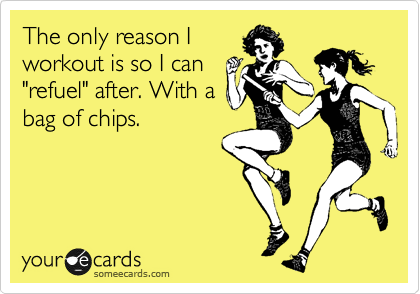I’ve found that there is a lot of confusion around protein powder and its role in fitness and nutrition, especially among women. Many think of protein powder as something only used by body builders and those who want to bulk up. Others might not necessarily be opposed, but have no idea what kind to buy or when to use it. I started drinking whey protein shakes post-workout about 6 months ago, and let me tell you, it has certainly made a difference for me both in recovery time as well as fat loss.
But I’m getting ahead of myself. First, I want to start with a brief discussion on the role of nutrition and its timing in exercise recovery. As we all know, it’s very important to fuel your body post-workout, whether you’re participating in endurance or weight training activities. After we exercise, our bodies go into a catabolic – or “breakdown” – state. The glycogen stores in our muscles are depleted and muscle fibers are broken down. The meal that we eat immediately after exercising can play a large role in restoring energy, repairing muscles, shortening recovery times and even changing body composition.
However, the quality and timing of your post-workout meal is very important.
The Metabolic Window
It has been shown that in order to achieve maximum benefits from exercise, a meal should be eaten no longer than 30-45 minutes after exercise. For those who exercise several times a week, this is especially important for recovery, as it can result in a 4-10 hour recovery period, as opposed to 24-36 hours.
The Optimal Combination
So now that you know when you should eat, you may be wondering what you should eat. While this depends on the type of exercise that you’re doing, for the purposes of this post, I’m going to assume a mixture of cardio and weight training.
It is important to consume carbohydrates post-exercise, as they play a key role in restoring glycogen in the muscles. However, combining protein with carbs post-exercise boosts glycogen synthesis more than consuming carbs alone and helps to further promote muscle repair. Studies have shown that 0.25-0.5g of protein per pound of lean body mass post-exercise is sufficient. But keep in mind that this varies by person based on their goals and specific nutrition needs.
As a general rule of thumb, the ideal carbohydrate to protein ratio of a post workout meal is 2:1. Here’s a nice little calculator that can help you get an idea of what that translates to (scroll to the bottom).
So any type of carb is ok, right?
Wrong.
Fast-acting carbs such as fruits are great immediately after a workout because they restore glycogen levels immediately, which aids in recovery. Slow-acting carbs such as sweet potatoes and steel cut oats restore glycogen levels at a slower, steadier rate. A combination of the two is optimal, but not always achievable when trying to stay within the metabolic window. I usually eat a banana immediately after I workout to get something into my body, and then about an hour or so later, I’ll have part of a sweet potato.
Ok, so where does protein powder enter the picture?
If you’re like me and you workout in the morning before heading straight to work (after a shower, I hope), it’s easy for an hour or even two to go by between finishing your workout and actually eating a meal. This is obviously way outside the metabolic window. Protein drinks and shakes are a great way to immediately get some protein into your body post-workout so that you don’t miss the window. They tend to be low in fat and calories and are easy to make and transport. You just throw a scoop or two of protein powder into your handy dandy blender bottle and add water. I usually eat a banana at the same time, or throw everything together in a blender to make a banana protein shake, which satisfies my carb:protein requirements.
Not all protein is created equal.
So what kind of protein should you buy? With all of the different products on the market, it’s very easy to get overwhelmed when walking into your local Vitamin Shoppe. I found this guide from Muffin Topless on buying protein powders to be very useful. Generally, you’ll want to look at the ingredient list and find one that does not contain excess sugar or harmful chemicals. You’ll also want to watch out for cheap filler ingredients, which may detract from the amount of protein you’re actually getting with each serving.
The most common types of protein include whey, casein and soy. I prefer whey, as it contains a higher level of amino acids and is digested and absorbed more rapidly, producing a higher rate of muscle protein synthesis at rest and after exercise.
Personally, I looooooooooove Protizyme Peanut Butter Cookie. Even mixed with water, it still tastes incredible. Blended with a banana and almond milk, you have yourself a peanut butter shake!
Whey is derived from milk, so if you’re lactose intolerant or have a milk allergy, soy protein is another option, although I’m not familiar enough on the topic to speak to it. There are also other sources such as pea and rice protein.
Hopefully this sheds some light on the stigma of protein powders, especially for you ladies out there! No need to be intimidated by protein shakes. Drink up!
Now I’m off to the gym for an ass-kicking followed by my own protein shake…
As always, comment if you have any questions!
Julia



